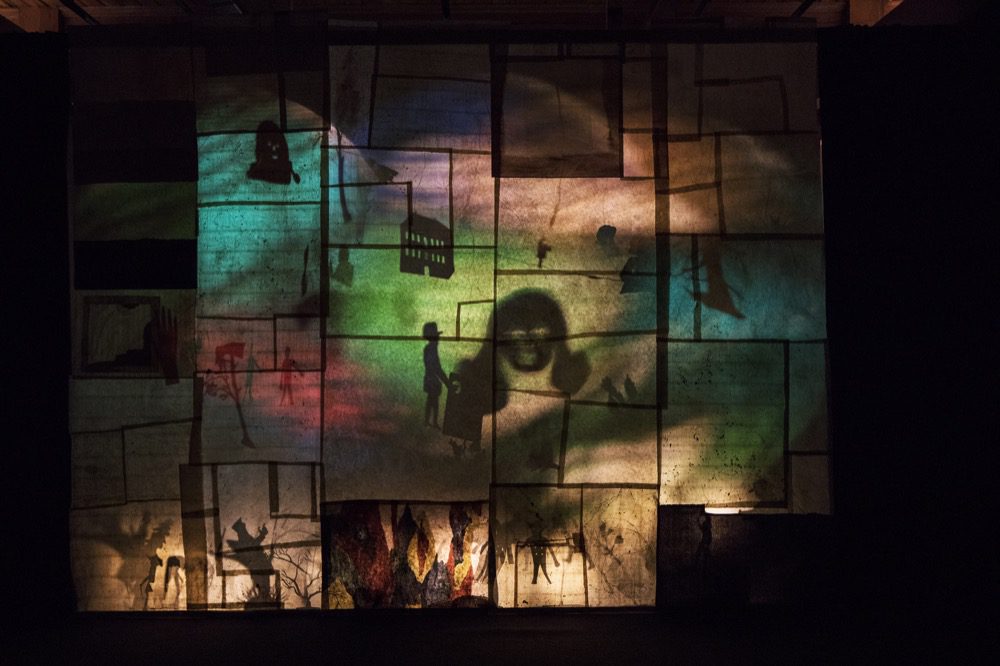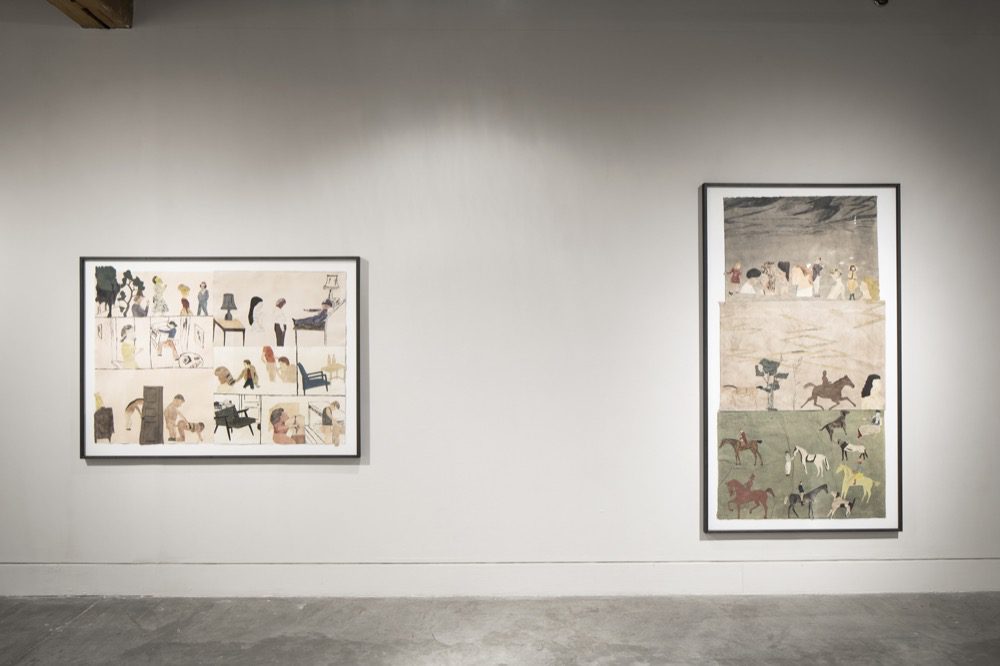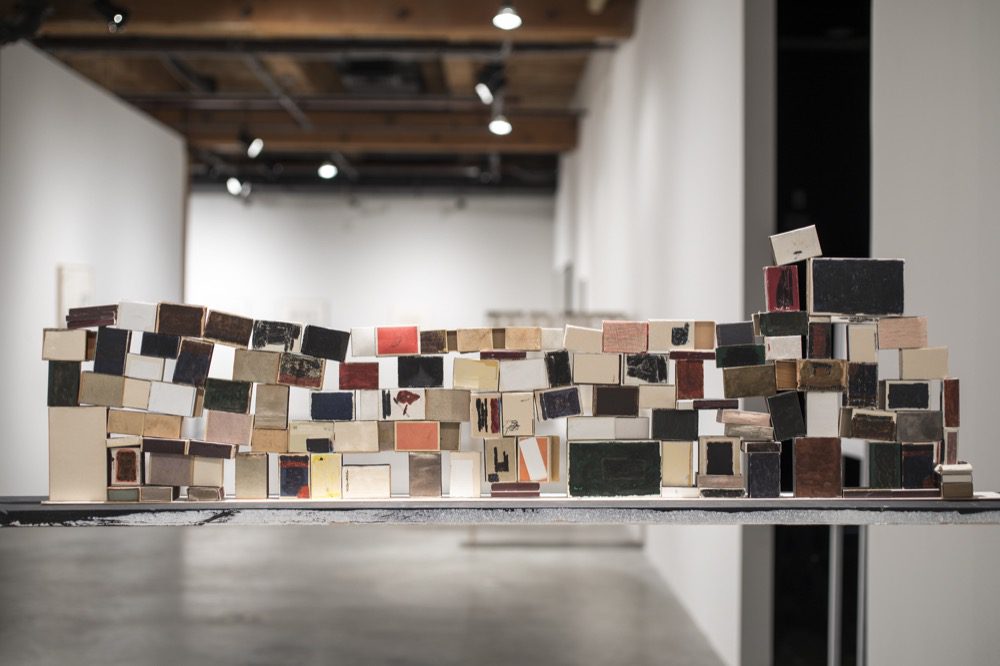Variations on a Theme: Jockum Nordström at the Contemporary Arts Center
Benjamin Morris visits Jockum Nordström’s sprawling survey exhibition at the Contemporary Arts Center.

Installation view of Jockum Nordström’s Why Is Everything a Rag, 2018, at the Contemporary Arts Center, New Orleans. Paper wires, tape, motors, lamps, and sound. Courtesy the artist and the Contemporary Arts Center, New Orleans.
Given the strange, alluring sounds emanating from the title piece in Jockum Nordström’s “Why Is Everything a Rag,” and the untold mysteries that its secluded chamber promises, it would be tempting for a visitor to skip the rest of the artist’s new show at the Contemporary Arts Center and head straight for the inner room where the installation awaits. Tempting, but foolish, for like a symphony whose finish would mean little without the crescendo before it, Nordström’s recent opus—a dreamlike morass of colorful light and shadows cast by cut-paper mobiles—can only be understood having first traveled through the past two decades of the artist’s work.
Such a journey is worth the time and effort. These works—on view in New Orleans for the first time—span a range of media including collage, drawing, architectural models, animation and short film, and collaborations with other artists on such materials as album covers and children’s books. Given both the range and the depth of Nordström’s oeuvre present, the consistency of his style across those media is readily apparent, and reflects a careful, conscious effort over twenty years to develop a robust visual language despite its seeming simplicity.
This seeming simplicity arises from Nordström’s signature cartoonish style, where his figures take on grotesque, outsized, and exaggerated features, sporting elongated torsos or legs or boasting bizarrely-shaped hips and noses and heads. Frequently his figures wear archaic, 19th-century clothing such as top hats and jerkins, adding to the seeming whimsy. While this style may seem childlike and outlandish in execution, the situations depicted frequently contain sex, violence, and other mature themes. In F.d. (före detta)/Ex. (the former), 2015, his figures seem to argue in one panel and copulate coldly in another, and in the line drawing The Dog and the Letter, 2016, a grim domestic drama is depicted but never explained, with the loose visual style underlying the tragedy of the scene.

Installation view of Jockum Nordström’s “Why is Everything a Rag” at the Contemporary Arts Center, New Orleans. Courtesy the artist and the Contemporary Arts Center, New Orleans.
For Nordström, certain elements recur as visual building blocks, his works heavily populated not just by bodies (both human and animal) but objects as well, including furniture, buildings, frames and mirrors, boats, and trees. In the exhibition wall texts, Nordström suggests these elements are drawn frequently from childhood memory; regardless, over time, they form a kind of vocabulary for a language that requires the strictures of narrative less and less. Many of his works hint at a story but, like those of Edward Hopper or Eric Fischl, never divulge it; others, such as Horsepeople, 2014, avoid it entirely, and still others seem more like concept pieces, visual executions of what a composer might call variations on a theme. In his collage Den nya musiken/The New Music, 2012, a hammer smashing a set of piano keys precedes a piano tuner standing at the instrument, followed last by a queue of people waiting outside. All these elements are superimposed over a background plane of paper that decays (viewing left to right) from a flat cream to beige and black cut strips, the old order seemingly broken and reassembled into novel arrangements: here, narrative is never formally established, but the title and the elements seem to speak to one another nevertheless.
Important to note in this context is that, cartoonish though his figures may be, Nordström does have a remarkable talent for depicting maximal information with a minimal array of elements. Matchboxes and cardboard create entire sculptural city blocks, blocks the mind can walk at length with ease. A few swatches of paper plus a dash of ink or marker, and suddenly living bodies emerge: shoulders slump, necks crane, and spines slouch, a vast array of human emotions—fear, indifference, laziness, lust—conveyed through his craft. One of the reasons these works are so effective is that glimmers of observed people and postures shine through the abstractions, often through these minute details—here the real and the imaginary collide.

Installation view of Jockum Nordström’s Bak rigel och bås, 2012, at the Contemporary Arts Center, New Orleans. Cardboard, matchboxes, paper, watercolor. Courtesy the artist and the Contemporary Arts Center, New Orleans.
Which is why encountering Why Is Everything a Rag, 2018, at the end of this journey through his work, is ultimately so moving. Entering the darkened recess of a separate chamber constructed on the gallery floor, the viewer finds a wall-sized shadow tableau of all the elements previously encountered, but here unified, like multiple different arts coming together to create an opera. Backlit by a gossamer haze of swirling colors, shadowy violets and seeping crimsons and piercing teals, a field of figures whirl around each other, figures such as the faces of men and women, disembodied hands, dogs at play in a forest, horses and bulls, isolated trees, and buildings frozen in space. Set on a loop over a background of experimental music by Nordström’s band, the piece feels altogether like watching a dream—not a dream remembered, but a dream in real time, with the soupiness of the atmosphere shot through with vivid, recognizable images and forms, images that call to mind specific experiences, emotions, and people.
Another way to describe it is like rewatching one’s childhood experiences as an adult, but somehow retaining the freshness and the mystery of those early perspectives. Either way, the effect is extraordinary, balancing the static and dynamic, the familiar and surreal, in perfect tension—like a Scandinavian take on Indonesian shadow gamelan. Spectral, hypnotic, soothing, and unnerving all at once, Why Is Everything a Rag feels less like a stand-alone piece than like a culmination of decades of effort. Resisting specific analysis or interpretation, it is perhaps best simply experienced. To attempt to explain it any further would be as foolish as missing the opportunity to see it in the first place.
Editor's Note
Jockum Nordström’s “Why Is Everything a Rag” is on view through June 17, 2018, at the Contemporary Arts Center (900 Camp Street) in New Orleans.



